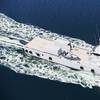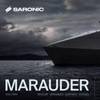Helicopter Mine Countermeasures Squadron (HM) 14, Detachment 1, and Mine Countermeasure Squadron (MCMRON) 7, completed the bilateral mine countermeasures exercise Clear Horizon with the Republic of Korea (ROK) Navy, Nov. 13.
Exercise Clear Horizon is an annual bilateral exercise between the U.S. and ROK navies that focus on increasing capabilities and coordination between ships, and aircraft in mine countermeasures in international waters surrounding the Korean peninsula.
"This exercise is a testament to the strong partnership between the U.S. and our ROK partners," said Rear Adm. Bill Byrne, the commander of Naval Forces Korea. "The threat of mines can have a crippling effect both militarily and economically and it is the enduring threat of mines in the waters around the peninsula that is the driving force behind this exercise."
Approximately 330 U.S. Navy personnel assigned to HM-14 and Explosive Ordnance Disposal Mobile Unit (EODMU) 5 participated in this year's exercise, which included U.S. and ROK units practicing clearing shipping routes and conducting training surveys.
"The largest take away for me regarding conducting an exercise like Clear Horizon is the coordination involved," said U.S. Navy Capt. Mike Dowling, MCMRON 7's commodore. "Effective coordination is critical in ensuring the U.S. and ROK team is prepared to counter any possible mine threat."
In an effort to better coordination and communication regarding flight deck operations, HM-14 teamed up with the ROK Navy ship Wonsan (MLS 560) to perform numerous take-off and landing drills, or DLQs, with a MH-53E Sea Dragon helicopter.
"There are only a few ships in our fleet that can accommodate the landing of an MH-53," said ROK Navy Cmdr. Kim, Ki-Hyun, commanding officer of the Wonsan. "This was important because it allowed our crew an opportunity to increase our proficiency in supporting various platforms."
Navy Lt. Cmdr. Sean Trombley of HM-14 agreed that the rare evolution was an important training opportunity.
"Anytime we deal with an international partnership it's important to establish standard procedures and communications," said Trombley, the weapons and tactical officer assigned to HM-14. "We were impressed with their professionalism and eagerness to to train with us so this was a great opportunity in which both sides benefited."
Commander, U.S. Naval Forces Korea is the regional commander for the U.S. Navy in the Republic of Korea and provides expertise on naval matters to area military commanders, including the Commander for the United Nations Command, the Combined Forces Command, and Commander, U.S. Forces Korea.






